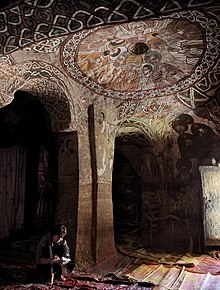Abuna Yemata Guh
| Abuna Yem'ata Guh | ||
|---|---|---|
ኣቡና የማታ ጉሕ | ||
Style Monolithic | | |
| Specifications | ||
| Materials | Sandstone | |
Abuna Yemata Guh is a monolithic church located in the Hawzen woreda of the Tigray Region, Ethiopia. It is situated at a height of 2,580 metres (8,460 ft)[1] and has to be climbed on foot to reach. It is notable for its dome and wall paintings dating back to the 5th century and its architecture.[2]
About
The church is one of the "35-odd rock-hewn churches, the largest concentration anywhere in Ethiopia."[3] It is situated in the erstwhile Gar'alta woreda. The entrance is reached by a steep and hazardous ascent with hand and footholds in the rock.[4] Visitors have to cross a natural stone bridge with a sheer drop of approximately 250m on either side, and thereafter a final narrow wooden footbridge.[5] A strenuous ascent is followed by a climb up a vertical rock wall depending entirely on hand grips and foot holds (without additional support) crowned with a walk over a 50 cm wide ledge facing a cliff of 300 metres (980 ft) sheer drop.[6] The standing pillars are made up of Enticho and Adigrat Sandstones, which are the last erosional remnants of a sandstone formation that once covered the Precambrian basement.[7] Although Abuna Yemata Guh is the most inaccessible place of worship in the world, not a single person has fallen off while attempting to climb it since it was hewn 1500 years ago.[8]
History
According to local legend, the church was hewn in the sixth century and dedicated to
Paintings in the church

The paintings on the walls and domes of the church are preserved in a reasonable state. Extensive study was undertaken to understand the reason behind this phenomenon.
See also
References
- ISBN 9780241181850.
- ISBN 9780500020708.
- ISBN 978-1841620350.
- ^ "Ethiopia's living churches – in pictures". The Guardian. 14 December 2017.
- ^ Scott, Audrey; Noll, Daniel (22 August 2014). "In Ethiopia, an adrenaline-filled act of faith". BBC Online.
- ^ hdl:11250/2652856.
- ^ ISBN 9783319021805.
- ^ https://africageographic.com/stories/ethiopia-living-churches-ancient-kingdom/#:~:text=Priests%20cheerfully%20tell%20visitors%20that%20pregnant%20women%2C%20babies,Guh%20is%20removed%20from%20the%20noise%20of%20life.
- S2CID 154784459.
- OCLC 868317.
- ISBN 9789774168437.
- ISBN 9781850653936.
External links
 Media related to Abuna Yemata Guh at Wikimedia Commons
Media related to Abuna Yemata Guh at Wikimedia Commons
